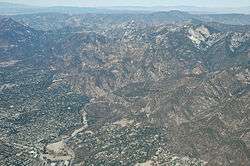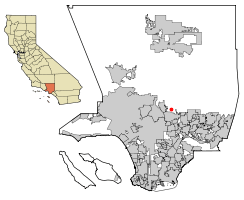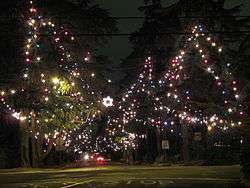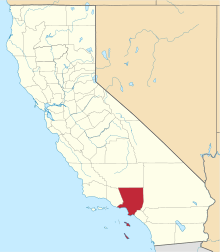Altadena, California
Altadena is an unincorporated[4] area[5] and census-designated place in Los Angeles County, California, United States, approximately 14 miles (23 km) from the downtown Los Angeles Civic Center, and directly north of the city of Pasadena, California. The population was 42,777 at the 2010 census, up from 42,610 at the 2000 census.
Altadena, California | |
|---|---|
 Aerial view of Altadena and Eaton Canyon | |
 Location of Altadena in Los Angeles County, California | |
 Altadena, California Location in the United States | |
| Coordinates: 34°11′19″N 118°8′5″W | |
| Country | |
| State | |
| County | |
| Area | |
| • Total | 8.73 sq mi (22.61 km2) |
| • Land | 8.71 sq mi (22.57 km2) |
| • Water | 0.02 sq mi (0.04 km2) 0.19% |
| Elevation | 1,358 ft (414 m) |
| Population (2017)[3] | |
| • Total | 45,236 |
| • Estimate (2016) | N/A |
| 2016 estimate: 45,001 | |
| Time zone | UTC−8 (Pacific) |
| • Summer (DST) | UTC−7 (PDT) |
| ZIP Codes | 91001, 91003 |
| Area code(s) | 626 |
| FIPS code | 06-01290 |
| GNIS feature IDs | 1652662, 2407732 |
History
In the mid-1860s, Benjamin Eaton first developed water sources from the Arroyo Seco and Eaton Canyon to irrigate his vineyard near the edge of Eaton Canyon. This made possible the development of Altadena, Pasadena, and South Pasadena. He did the construction for B. D. Wilson and Dr. John Griffin, who jointly owned the Mexican land grant of Rancho San Pascual, about 14,000 acres (57 km2), that was the future sites of these three communities. They hoped to develop and sell this land in a real estate plan called the San Pasqual Plantation. Their efforts failed by 1870, despite Eaton's irrigation ditch that drew water from the site of present-day Jet Propulsion Laboratory in Arroyo Seco, because the land was relatively inaccessible and few believed crops could thrive that close to the mountains.
Eaton tried to sell the land for the partners, and in late 1873 he helped broker a deal with Daniel Berry, who represented a group of investors from Indiana, to buy 4,000 acres (16 km2) of the rancho. This included the land of present-day Altadena, but they developed a 2,500 acres (10 km2) section further south as Pasadena. In 1881, the land that would later become Altadena was sold to John and Fred Woodbury, brothers who launched the subdivision of Altadena in 1887. The land remained primarily agricultural, though several eastern millionaires built mansions along Mariposa Street, and a small community developed through the 1890s and into the next century.

In 1880, Capt. Frederick Woodbury, and his brother, John Woodbury of Marshalltown, Iowa, purchased 937 acres (3.79 km2) known as the Woodbury Ranch. John Woodbury established the Pasadena Improvement Company in 1887, with a plot plan of residential development referred to as the Woodbury Subdivision. They contacted Byron O. Clark, who established a nursery in the foothills in 1875, and had since moved away. He called his nursery "Altadena Nursery", a name he coined from the Spanish "alta" meaning "upper", and "dena" from Pasadena. Woodbury asked if he could use the name "Altadena" for his subdivision and Clark agreed.
The newly sprouted community of Altadena immediately began to attract millionaires from the East. In 1887 Andrew McNally, the printing magnate from Chicago, and his good friend Col. G. G. Green, had built mansions on what was to become Millionaire's Row; Mariposa Street near Santa Rosa Avenue. Newspaper moguls William Armiger Scripps and William Kellogg built homes side by side just east of Fair Oaks Avenue. A bit farther east, Zane Grey bought a home from Arthur Herbert Woodward, and added a second-floor study. The famous Benziger Publishing Company built a mansion on the corner of Santa Rosa Avenue (Christmas Tree Lane) and Mariposa. Mariposa was taken from the Spanish name for a butterfly. The grandson of Andrew McNally, Wallace Neff, became a famous Southern California architect. He started his career in Altadena with the design and construction of St. Elizabeth of Hungary Catholic Church (parish est.1918, which was dedicated in October 1926.
Redlining policies prevented African Americans from acquiring land or purchasing property in much of California.[6][7] One of the areas exempt from these policies was Altadena Meadows which thrived and became one of first middle-class African American neighborhoods in the area.[7]
Over the years Altadena has been subject to attempted annexation by Pasadena. Annexation was stopped in 1956 by community campaigns, though it has been resurrected several times since by Pasadena without success. Had the annexation succeeded, Pasadena would be the 108th largest city in the United States.
While Altadena long refused wholesale annexation by neighboring Pasadena, the larger community nibbled at its edges in several small annexations of neighborhoods through the 1940s. With early 1960s redevelopment in Pasadena, the routing of extensions of 134 and 210 freeways, and lawsuits over the desegregation of Pasadena Unified School District, there was white flight and convulsive racial change in Altadena. In 1960, its black population was under four percent; over the next 15 years, half the White population left, and was replaced by people of color, many of whom settled on the west side of town after being displaced by Pasadena's redevelopment and freeway projects.
The name Altadena derives from the Spanish alta, meaning "upper", and dena from Pasadena; the area is adjacent to, but at a higher elevation than, Pasadena.[8]
Geography
According to the United States Census Bureau, the CDP has a total area of 8.7 square miles (23 km2), over 99% of it land.
Climate
Altadena experiences hot and dry summers that are followed by warm and windy falls. According to the Köppen Climate Classification system, Altadena has a hot-summer Mediterranean climate, abbreviated "Csa" on climate maps.
| Climate data for Altadena, California (1893–2016; extremes since 1927) | |||||||||||||
|---|---|---|---|---|---|---|---|---|---|---|---|---|---|
| Month | Jan | Feb | Mar | Apr | May | Jun | Jul | Aug | Sep | Oct | Nov | Dec | Year |
| Record high °F (°C) | 93 (34) |
92 (33) |
98 (37) |
105 (41) |
104 (40) |
113 (45) |
110 (43) |
107 (42) |
111 (44) |
108 (42) |
101 (38) |
93 (34) |
113 (45) |
| Average high °F (°C) | 66.5 (19.2) |
67.8 (19.9) |
69.9 (21.1) |
73.4 (23.0) |
76.3 (24.6) |
81.7 (27.6) |
88.4 (31.3) |
89.2 (31.8) |
87.1 (30.6) |
80.6 (27.0) |
73.8 (23.2) |
67.2 (19.6) |
76.8 (24.9) |
| Average low °F (°C) | 42.6 (5.9) |
44.1 (6.7) |
45.9 (7.7) |
48.8 (9.3) |
52.2 (11.2) |
55.7 (13.2) |
59.9 (15.5) |
60.3 (15.7) |
58.5 (14.7) |
53.4 (11.9) |
47.2 (8.4) |
43.2 (6.2) |
51.0 (10.6) |
| Record low °F (°C) | 21 (−6) |
26 (−3) |
29 (−2) |
31 (−1) |
32 (0) |
41 (5) |
45 (7) |
43 (6) |
41 (5) |
36 (2) |
26 (−3) |
25 (−4) |
21 (−6) |
| Average rainfall inches (mm) | 4.60 (117) |
4.79 (122) |
3.54 (90) |
1.80 (46) |
0.43 (11) |
0.17 (4.3) |
0.03 (0.76) |
0.10 (2.5) |
0.42 (11) |
0.84 (21) |
2.01 (51) |
3.26 (83) |
22.00 (559) |
| Average rainy days (≥ 0.01 inch) | 7.2 | 6.7 | 7.7 | 4.1 | 2.8 | 1.6 | 0.5 | 0.7 | 1.7 | 2.6 | 3.4 | 4.8 | 43.8 |
| Source 1: WRCC[9] | |||||||||||||
| Source 2: WRCC[10] | |||||||||||||
The wettest calendar year was 1983 with 48.47 inches (1,231.1 mm) and the driest 1947 with 5.37 inches (136.4 mm). The most rainfall in one month was 19.70 inches (500.4 mm) in February 1980. The most rainfall in 24 hours was 7.70 inches (195.6 mm) on March 2, 1938. Altadena averages 21.09 inches (535.7 mm) of rain a year, over 6 inches (150 mm) more than nearby Los Angeles due to the orographic effect created by the San Gabriel Mountains. Because of the slope on which the city is built, sewer lines in the city's northern section have been known to overflow significantly.
Demographics
2010
| Historical population | |||
|---|---|---|---|
| Census | Pop. | %± | |
| 1960 | 40,568 | — | |
| 1970 | 42,415 | 4.6% | |
| 1980 | 40,983 | −3.4% | |
| 1990 | 42,658 | 4.1% | |
| 2000 | 42,610 | −0.1% | |
| 2010 | 42,777 | 0.4% | |
| sources:[11][12] | |||
The 2010 United States Census[13] reported that Altadena had a population of 42,777. The population density was 4,900.4 people per square mile (1,892.1/km2). The racial makeup of Altadena was 22,569 (52.8%) White (40.3% Non-Hispanic White),[14] 10,136 (23.7%) African American, 300 (0.7%) Native American, 2,307 (5.4%) Asian, 71 (0.2%) Pacific Islander, 4,852 (11.3%) from other races, and 2,542 (5.9%) from two or more races. Hispanic or Latino of any race were 11,502 persons (26.9%).
The Census reported that 42,276 people (98.8% of the population) lived in households, 234 (0.5%) lived in non-institutionalized group quarters, and 267 (0.6%) were institutionalized.
There were 15,212 households, out of which 5,170 (34.0%) had children under the age of 18 living in them, 7,684 (50.5%) were opposite-sex married couples living together, 2,210 (14.5%) had a female householder with no husband present, 814 (5.4%) had a male householder with no wife present. There were 661 (4.3%) unmarried opposite-sex partnerships, and 271 (1.8%) same-sex married couples or partnerships. 3,489 households (22.9%) were made up of individuals, and 1,318 (8.7%) had someone living alone who was 65 years of age or older. The average household size was 2.78. There were 10,708 families (70.4% of all households); the average family size was 3.26.
The age distribution of the city's population was as follows: 9,507 people (22.2%) were under the age of 18, 3,286 people (7.7%) aged 18 to 24, 10,622 people (24.8%) aged 25 to 44, 13,298 people (31.1%) aged 45 to 64, and 6,064 people (14.2%) who were 65 years of age or older. The median age was 41.8 years. For every 100 females, there were 93.1 males. For every 100 females age 18 and over, there were 89.2 males.
There were 15,947 housing units at an average density of 1,826.8 per square mile (705.4/km2), of which 10,889 (71.6%) were owner-occupied, and 4,323 (28.4%) were occupied by renters. The homeowner vacancy rate was 0.9%; the rental vacancy rate was 4.9%. 30,319 people (70.9% of the population) lived in owner-occupied housing units and 11,957 people (28.0%) lived in rental housing units.
According to the 2010 United States Census, Altadena had a median household income of $82,895, with 10.7% of the population living below the federal poverty line.[14]
2000
As of the census[15] of 2000, there were 42,610 people, 14,780 households, and 10,671 families residing in the CDP. The population density was 4,898.9 people per square mile (1,891.0/km2). There were 15,250 housing units at an average density of 1,753.3 per square mile (676.8/km2). The racial makeup of the CDP was 47.30% White, 31.42% Black or African American, 0.58% Native American, 4.24% Asian, 0.13% Pacific Islander, 10.19% from other races, and 6.14% from two or more races. 20.39% of the population were Hispanic or Latino of any race.
There were 14,780 households, out of which 34.1% had children under the age of 18 living with them, 52.3% were married couples living together, 15.2% had a female householder with no husband present, and 27.8% were non-families. 21.8% of all households were made up of individuals, and 7.1% had someone living alone who was 65 years of age or older. The average household size was 2.82 and the average family size was 3.29.
In the CDP, the population was spread out, with 26.6% under the age of 18, 6.4% from 18 to 24, 30.1% from 25 to 44, 24.6% from 45 to 64, and 12.3% who were 65 years of age or older. The median age was 38 years. For every 100 females, there were 91.8 males. For every 100 females age 18 and over, there were 86.6 males.
The median income for a household in the CDP was $60,549, and the median income for a family was $66,800 (these figures had risen to $77,020 and $86,778 respectively as of a 2007 estimate). Males had a median income of $49,098 versus $38,054 for females. The per capita income for the CDP was $27,604. About 7.4% of families and 10.6% of the population were below the poverty line, including 14.1% of those under age 18 and 8.3% of those age 65 or over.
Arts and culture
Points of interest
Christmas Tree Lane is a 0.7-mile (1.1 km) stretch of Santa Rosa Avenue from Woodbury Road to Mariposa Street.[16] It has been a holiday attraction since 1920, and it is the oldest large-scale outdoor Christmas lighting venue in the world. Each December, members of the Christmas Tree Lane Association[17] festoon the 110 still standing giant deodars that line the street with thousands of Christmas lights. Christmas Tree Lane was placed on the National Register of Historic Places in 1990,[16] and is a California Historical Landmark.[18]
Among Altadena's Christmas lighting attractions was the Balian Mansion, which drew people worldwide for tours of its Christmas lighting display. The Balian Mansion display was lit during the holiday season from 1955 to 2016, and is arguably the pioneer of home holiday lighting. The Balian home is located just east of Allen Avenue, at the 3-point junction of Mendocino Street, Mendocino Lane, and Glenview Terrace.
The historic Mount Lowe Railway was a scenic railway that once carried passengers to any of four resort hotels high in the San Gabriel Mountains above Altadena and Pasadena. Although the mountains and the remains of the railway are not strictly in Altadena, the most direct trail to the sites, the Sam Merrill Trail, starts in Altadena at the top of Lake Avenue, and leads to Mount Echo, about 3 miles (4.8 km). Chaney Trail, just west of the intersection at Fair Oaks Avenue and Loma Alta Street, is a forestry service road leading to the old right of way. The Mount Lowe Railway site was placed on the National Register of Historic Places in 1993.
Altadena has a number of hiking trails, including the trail to the Dawn Mine, which can be reached via Chaney Trail to Sunset Ridge Trail. Arrows painted on large boulders direct hikers along the way.
The Cobb Estate at the top of Lake Avenue is now a free botanical garden, operated by the United States Forest Service. It is guarded by its historic gates, which are easily bypassed to allow visitors and hikers to ascend its long and winding paved driveway to the site of what was once one of Altadena's premier mansions. This site is also found alongside the Sam Merrill Trail, which accesses Las Flores Canyon on the way to Echo Mountain.
Farnsworth Park located on Lake Avenue is a large county park that offers picnic grounds, play areas, and a club house and amphitheater. It was placed on the National Register of Historic Places in 1997.
Crudely Hewn Tombstone is the final resting place of abolitionist and survivor of the attack of Harpers Ferry, Owen Brown. The Tombstone which is the only known memorial for Owen Brown reads "Owen Brown, son of John Brown, the Liberator, died Jan. 9, 1889, aged 64 years.” and is located on Round Top Hill near Brown mountain in an isolated part Angeles National Forest.[19]
Infrastructure
The Los Angeles County Sheriff's Department (LASD) operates the Altadena Station in Altadena.[20]
The California Highway Patrol operates the Altadena Area Office on Windsor Dr. in Altadena.
Altadena is a shared jurisdiction where L.A. County Sheriff's Dept. handles crime-related calls and CHP handles traffic-related calls.
The Los Angeles County Department of Health Services operates the Monrovia Health Center in Monrovia, serving Altadena.[21]
Notable people
- Nahshon Dion Anderson, writer and screenwriter[22]
- Aja Brown, mayor of Compton, California
- Owen Brown, abolitionist
- Claude Akins, actor
- Sona Movsesian, assistant of Conan O'Brien
- Ramses Barden, NFL player
- Al Boeke, architect and developer of Sea Ranch, California[23]
- Octavia Butler, author[24]
- Andre Coleman, reporter and author
- Fannie Charles Dillon, composer
- Richard Feynman, physicist, was a resident.[25]
- Jonathan Gold, Pulitzer Prize-winning restaurant critic
- Rodney King, police brutality victim[26]
- Bob Lillis, Major League Baseball player and coach
- Paul Little, adult entertainment director and actor
- Mo Martin, LPGA golfer
- Jim Merritt, Major League Baseball pitcher
- Roger Nelson, Major League Baseball pitcher
- Marni Nixon, singer
- Nathaniel Rosen, classical cellist
- Steve Sailer, author, blogger, and movie critic
- Michael Shermer, founder of The Skeptics Society and Editor in Chief of its magazine, Skeptic
- Ethelynde Smith, concert singer and botanical painter
- Adam Steltzner, spacecraft engineer
- Darryl Stephens Actor
- Jeffrey C. Stewart Pulitzer prize winner and Professor [27]
- Sharon Stouder, swimmer, three gold medals in 1964 Summer Olympics
- Meshach Taylor, Emmy-nominated actor, Designing Women
- Leslie Van Houten, Manson Family member serving life sentence for murder
- Mark Dean Veca, artist
- Alice Walker, author of The Color Purple
- Charles White (artist) printmaker and draftsman
- Harold Zirin, solar astronomer, founder of the Big Bear Solar Observatory
- Jirayr Zorthian, artist
See also
References
- "2016 U.S. Gazetteer Files". United States Census Bureau. Retrieved July 19, 2017.
- "Altadena". Geographic Names Information System. United States Geological Survey. Retrieved October 19, 2014.
- "American Fact Finder: 2013-2017 American Community Survey 5-Year Estimates". US Census Bureau. Retrieved January 25, 2019.
- Los Angeles County publication: "Unincorporated Areas within the County of Los Angeles", Altadena listed by Los Angeles County government office, as an unincorporated city Archived May 27, 2010, at the Wayback Machine, "Los Angeles County publication: 'Unincorporated Areas within the County of Los Angeles'", verified September 27, 2010
- Los Angeles County Office of Unincorporated Area Services, Altadena listed by Los Angeles County government office, as an unincorporated area, "Los Angeles County Office of Unincorporated Area Services", verified September 27, 2010
- "Segregation in the City of Angels: A 1939 Map of Housing Inequality in L.A." KCET. November 14, 2017. Retrieved August 14, 2018.
- "Altadena's own take on Civil War monuments honors abolitionist Owen Brown in revamped park". Pasadena Star News. November 13, 2017. Retrieved August 14, 2018.
- Manning, Mike. The word Altadena was first used by Byron Clark, who coined it for his nursery located south of present-day Woodbury on the west side of town. When he moved his nursery to Linda Vista, he agreed to let the Woodburys take the name for their new subdivision. "ALTADENA, CALIFORNIA: an abbreviated history for the internet Archived April 24, 2005, at the Wayback Machine". Altadena Town Council. Retrieved on March 18, 2007.
- "PASADENA, CALIFORNIA - Climate Summary". WRCC. Retrieved October 3, 2017.
- "ALTADENA, CALIFORNIA - Climate Summary". WRCC. Retrieved October 3, 2017.
- "CENSUS OF POPULATION AND HOUSING (1790-2000)". U.S. Census Bureau. Retrieved July 17, 2010.
- US Census Bureau
- "2010 Census Interactive Population Search: CA - Altadena CDP". U.S. Census Bureau. Archived from the original on April 3, 2015. Retrieved July 12, 2014.
- "State & County QuickFacts: Altadena CDP, California". Archived from the original on July 1, 2012.
- "U.S. Census website". United States Census Bureau. Retrieved January 31, 2008.
- "Weekend: Christmas Tree Lane's 97th Year". NBC Southern California. Retrieved August 14, 2018.
- http://www.christmastreelane.net/
- "Set aside a night for Altadena's Christmas Tree Lane". Tilma. Archived from the original on August 15, 2018. Retrieved August 14, 2018.
- RASMUSSEN, CECILIA (January 30, 2000). "John Brown's Son Escaped to Southland". Los Angeles Times. ISSN 0458-3035. Retrieved August 14, 2018.
- "Altadena Station Archived January 9, 2010, at the Wayback Machine." Los Angeles County Sheriff's Department. Retrieved on January 21, 2010.
- "Monrovia Health Center." Los Angeles County Department of Health Services. Retrieved on March 27, 2010.
- "2016 Writers Retreat Fellows". Lambda Literary. Retrieved April 22, 2016.
- Hevesi, Dennis (November 16, 2011). "Al Boeke, Architect Who Sought Ecological Harmony, Is Dead at 88". The New York Times. Retrieved December 3, 2011.
- "Tracing Octavia Butler's Footsteps: An Interview with Dr. Ayana A. H. Jamieson - Los Angeles Review of Books". lareviewofbooks.org. Retrieved March 23, 2018.
- Wilson, Larry (November 1, 2016). "Altadena's history on view, from Richard Feynman to Bugsy Siegel: Larry Wilson". pasadenastarnews.com. Retrieved February 24, 2020.
- "Rodney King, L.A. police beating victim, dies". San Francisco Chronicle. June 18, 2012.
- "Jeffrey Stewart". Altadena Heritage. Retrieved February 18, 2020.
Further reading
- Ives, Sarah Noble, Altadena. Pasadena, California: The Star-News Publishing Co., 1938. Out of print.
- Peterson, Robert H. Altadena's Golden Years. Alhambra, California: Sinclair Printing and Litho, Inc., 1976.
- Zack, Michele. Altadena: Between Wilderness and City. Altadena, California: Altadena Historical Society, 2004. ISBN 0-9747257-0-6
External links
| Wikimedia Commons has media related to Altadena, California. |


